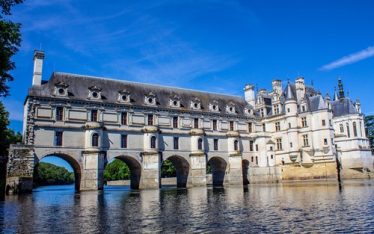Another day another Chateau. Silver Travel Advisor journalist Helen Jackson explains the interest and beauty of Chateau de Nitray whilst cruising on the barge Nymphea, on the Loire Valley’s River Cher. Our first shore visit was to Château de Nitray, a five minute drive from our mooring.
Although the château dates back to the 12th century, it was rebuilt in 1560 and the original foundations, which were of a slightly different coloured stone, were still discernible. It was the only château we visited on our all-inclusive, six-night cruise that is still in private ownership. Seventeen families have lived in the château, and since 1989, Earl Hubert de l’Espina has welcomed visitors for functions and wine tastings.
Although the house isn’t open to the public, we admired the white tuffeau stone, a local limestone of the Loire Valley. The flamboyant decorations above the top windows were Botticelli in style and the left 2/3rds of the long, slim château were symmetrical to either side of the wooden door, whilst the right third was asymmetrical to break the monotony.
The small chapel had two stained glass windows and we heard how the blue paint would have originally been lapis lazuli.
The prison had three levels: the bottom for minor offences like stealing food; the middle for more serious offences, for example insulting the king; and the third, for those sentenced to death. The remains of a five-bar gate etched into the wall were still visible: possibly denoting days or weeks of incarceration.

The Pigeonnier
The pigeon house, or pigeonnier, was a fabulous round structure and is said to be one of the best examples in France. Thousands of small rectangular holes, boulins, around the interior walls allowed the pigeons to nest. A pole in the middle from floor to ceiling connected to a ladder. The eggs were collected by climbing the ladder and propelling yourself around the wall using your feet. We were told that in the north of France, pigeons were used as messengers, but in the poorer south, the eggs and possibly the birds, would have been eaten. Droppings were also collected and used as fertiliser.
Hunting was a major pastime and the stables, with antlers and ancient weapons adorning the walls, had stalls for stabling the horses in pairs, although the owner’s steed had a private box. Above the stables were a series of function rooms used to host weddings and events which explained the coat racks in the horse stalls
In the garage we found a wonderful, dust-covered, liveried Peugeot 2003 van used for deliveries and next door was the original bakery with bread oven. Whilst touring the vegetable garden we heard about the six grape varieties grown on the 10 hectares: 3 red (Cabernet Franc, Cot and Grolleau) and 3 white, (Sauvignon Blanc, Chardonnay and Chenin).
Before our tasting experience began, we visited the wine warehouse and saw ancient tools used to produce wine, including one which manually inserted corks one at a time.
In the courtyard we sat under the shade of a tree to taste. We tried five wines starting with a sparkling made in 2009 from 100% Chenin, which in the area, can be known as Pineau de la Loire. Next up was a Chenin half dry, followed by a rose made from Cabernet Franc and Grolleau, the latter indigenous to the Loire. The first red was a light and fruity Cuvee Carbonelle, made from handpicked Cabernet Franc grapes. It was said to be produced using the macération carbonique methode, although as I’d being swallowing rather than spitting, the finer points of this defeated me! Our final wine was made from the Cot or Malbec grape and was called Cȏtcȏt Codette. All the wines bore a distinctive label featuring an outline sketch of the chateau.
After a fabulous visit we returned to the Nymphea with three bottles to accompany our meals. We enjoyed a Chateau Nitray Sauvignon Blanc, which we’d not tasted, with a starter of grilled goat’s cheese on crostini with poached apricots and salad leaves. A perfect combination and a perfect end to our day.





